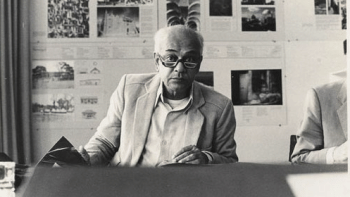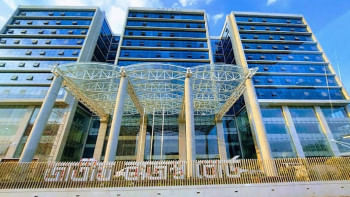Death of an architecture

The Mir Mosharraf Hossain Hall, a student dormitory at the Jahangirnagar University, is a landmark in Bangladesh's contemporary architecture. It will always be included in the top 10 modern buildings of Bangladesh. Designed by the master architect Muzharul Islam in the late 1960s, the design of the dormitory was a result of his sustained investigation of an architectural complex that responded to the parameters of climate, landscape and urban pattern.
Now this iconic building is destined for destruction. If carried out, it will be the death of an architectural icon. All of us should be outraged.
There are particular reasons why this building is distinctive. First, it was conceived as an architecture for a collective dwelling (dormitory, in this case). There are very few examples that we can cite from Bangladesh that demonstrate a creative arrangement of a complex or ensemble for a collective habitation. Second, the unique form of the building—a diagonal geometry, or two triangles kissing one another—is derived from Islam's inquiry into orthogonal buildings with courtyards that needed equal treatment of sun control and cross-ventilation on all sides. The answer was an angled volume in which all sides received similar climatic conditions. Courtyards in the middle provided for a shared, landscaped space. Third, the unique form of the building with its sharp diagonal shapes in a robust brick construction that, from the air, looked like an unfolding butterfly captured the imagination of many. Additionally, being over 50 years old, many previous residents recall the building with fond memories. In short, the building has achieved an iconic status.
The design of the student dormitory was part of Muzharul Islam's larger proposed master plan for Jahangirnagar University. The master plan was equally unique and truly masterly; no other urban planner or architect working at a large scale has been able to match the sophistication of Jahangirnagar University's master plan. Other than Chittagong University, which was also planned by Muzharul Islam around the same time, the plan of Jahangirnagar University represented the complete vision of a university by a Bengali architect.
Conceived of as an integrated campus of buildings and spaces in which a mesh of diagonal geometry integrated with the natural landscape of the area, the master plan presented a forward-looking vision for its time. The tilted square plan of the dormitory reflected the larger geometric order of buildings, common spaces and pathways. I have described it elsewhere that the plan reflected Islam's attempt to imagine a new urban pattern. The sharp geometry of the architecture was a deliberate counterpart to the fluidity of natural forms, whether it was an existing canal or groves of trees.
But as events developed into the 1970s, subsequent administrations did not follow Islam's plan other than building the dormitory and a few staff quarters. Whether it was lack of a vision for their own campus or an antipathy for the architect, the administration opted for new buildings with other designers. Each new building since then was one monumental ordinariness after another—it neither contributed to the culture of architecture nor created an inspiring ambience of a university. The promise for a world class campus was lost.
And now it appears that the remaining building by Islam, the magnificent Mir Mosharraf Hossain Hall, is earmarked for demolition. The plan to demolish was first reported by a Bengali daily at this very time last year. It appeared that engineers and consultants from Rajuk identified certain buildings as "seismically vulnerable" with further recommendation for either retrofitting or immediate demolition. Mir Mosharraf Hossain Hall was marked for "immediate" demolition at that time.
Shocked by the news, and curious about the projected rapidity to demolish, my friend and colleague Jalal Ahmed, a prominent architect and past president of the Institute of Architects Bangladesh (IAB), wrote a letter to the vice-chancellor of the university. We also visited the campus. The letter noted: "Architect Muzharul Islam, who is also known as Sthapatyacarya, laid the foundation of modern architecture in Bangladesh, and through his masterful buildings and committed work inspired generations of architects. Muzharul Islam received many national and international recognitions, including Shadhinata Padak. When alive, he was a presidium member of the Bangladesh Awami League. The Institute of Architects Bangladesh (IAB) had taken an initiative of preserving all the works of Muzharul Islam as part of UNESCO World Heritage List which has the blessing and support of the Hon. Prime Minister."
We also pointed out that Muzharul Islam's plan for Jahangirnagar University has been appreciated as original and groundbreaking in the history of planning in Bangladesh as a unique concord between urbanism and nature, and the few buildings that were built as part of the plan were lauded as masterful and world-class. The Mir Mosharraf Hussain Hall is one such building. In the arrangement of the plan and as a building type, there is no parallel to that building in Bangladesh. Buildings like that contribute to the cultural heritage of a country.
We visited the campus and the building on death row, and reviewed the damaging areas that were highlighted in the investigation of the Rajuk consultants. It appeared that only certain points of the whole structure were as vulnerable. If that is the case, we were not sure why the whole complex had to be taken down. We were also not sure why, considering the national status of Muzharul Islam and the international standing of his work, the dormitory building cannot be retrofitted. That should be the only option. We met the vice-chancellor and other administrative officials who all seemed to favour keeping the building. The vice-chancellor recalled his time living in the dormitory as a student.
Mir Mosharraf Hossain Hall is not the only building in the country with such a death knell. It is part of a larger practice. It appears that there is a quiet but relentless campaign to take down whatever is considered old or outdated, in some pretext or another, so that it could be replaced with a new structure (in most cases, by a building of a mediocre quality). We can cite the demolition of a Krishi Khamar building in Tejgaon, the colonial period hostels in Sylhet, and the ongoing issue with the Teachers-Students Centre at Dhaka University. This is nothing less than a cultural carnage.
We have seen the world over, especially on many university campuses, some I have been associated with, that every care is taken to preserve the edifices of the past. There is a richer dialogue when the past is preserved with the new following that. Preservation also aligns with the principles of sustainability and conservation. Such a considered position requires an informed and dedicated orientation. But we are seeing all across the country that the fate of heritage buildings rests upon people with "technical expertise" who often lack architectural knowledge and the cultural value of buildings.
We can only plead for a little compassion here. No matter what the expense for retrofitting is, Mir Mosharraf Hossain Hall should be retained, restored and brought back to its original self. The year 2023 was the birth centenary of the country's most famous architect, Muzharul Islam. Many of his buildings, including the Hall, are currently being assessed for the UNESCO World Heritage List. At such a time, we should plan for conservation, not destruction.
Kazi Khaleed Ashraf is an architect and writer, and directs the Bengal Institute for Architecture, Landscapes and Settlements.
Views expressed in this article are the author's own.
Follow The Daily Star Opinion on Facebook for the latest opinions, commentaries and analyses by experts and professionals. To contribute your article or letter to The Daily Star Opinion, see our guidelines for submission.

 For all latest news, follow The Daily Star's Google News channel.
For all latest news, follow The Daily Star's Google News channel. 








Comments